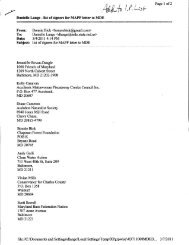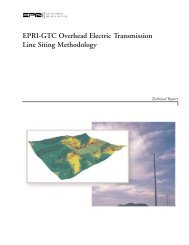Mid-Atlantic Power Pathway Chalk Point Substation to Indian River ...
Mid-Atlantic Power Pathway Chalk Point Substation to Indian River ...
Mid-Atlantic Power Pathway Chalk Point Substation to Indian River ...
You also want an ePaper? Increase the reach of your titles
YUMPU automatically turns print PDFs into web optimized ePapers that Google loves.
<strong>Mid</strong>-<strong>Atlantic</strong> <strong>Power</strong> <strong>Pathway</strong> Environmental Review Document<br />
<strong>Chalk</strong> <strong>Point</strong> <strong>Substation</strong> <strong>to</strong> <strong>Indian</strong> <strong>River</strong> <strong>Substation</strong> Volume II – Environmental Analysis of<br />
April 13, 2011 <strong>Chalk</strong> <strong>Point</strong> <strong>Substation</strong> <strong>to</strong> MD/DE State Line<br />
Table 1.1-1<br />
Physiographic Regions, Districts, and Areas Crossed by the<br />
Proposed Project Right-of-Way<br />
Physiographic Region Physiographic District Project Segment<br />
Western Shore Lowland<br />
Region<br />
Western Shore Upland<br />
Region<br />
Chesapeake Bay Estuary<br />
Region a<br />
Patuxent Estuaries and<br />
Lowlands<br />
Prince Frederick Knobby<br />
Upland District (including the<br />
Calvert Cliffs Area)<br />
Delmarva Peninsula Region Princess Anne Lowland<br />
District (including the<br />
Nanticoke <strong>River</strong> Area)<br />
Salisbury Plain District<br />
1-4<br />
<strong>Chalk</strong> <strong>Point</strong> <strong>Substation</strong> <strong>to</strong><br />
Chestnut Converter<br />
<strong>Chalk</strong> <strong>Point</strong> <strong>Substation</strong> <strong>to</strong><br />
Chestnut Converter, Calvert<br />
Converter Station, Calvert<br />
Converter Station <strong>to</strong> Western<br />
Shore Landing<br />
NA Western Shore Landing <strong>to</strong><br />
Gateway Converter<br />
a The Chesapeake Bay and Choptank <strong>River</strong> crossings are discussed in detail in Volume III.<br />
Western Shore Landing <strong>to</strong><br />
Gateway Converter, Gateway<br />
Converter, Choptank <strong>River</strong><br />
Landfall <strong>to</strong> MD/DE Stateline<br />
The Delmarva Peninsula Region’s northern boundary in Maryland is the Elk <strong>River</strong>; the boundary extends<br />
east and south in<strong>to</strong> Delaware and Virginia respectively with the remaining boundaries along the <strong>Atlantic</strong><br />
shoreline on the southeast and the Chesapeake Estuary Bay Region on the west. This large peninsula<br />
separates the Chesapeake Bay and the Delaware Bay <strong>Atlantic</strong> drainages and has grown southward by<br />
accretion during the Neocene period. Sediments underlying this region are generally unconsolidated<br />
sands, silts, clays, pebbles, and cobbles. Within this district, the Project crosses the Princess Anne<br />
Lowland District and the Salisbury Plain District. The Princess Anne Lowland District is a lowland plain<br />
of very low relief, including the Nanticoke <strong>River</strong> Area. The Nanticoke <strong>River</strong> Area is characterized as<br />
largely swamp and marsh occupying the Nanticoke <strong>River</strong> floodplain. The Salisbury Plain District is a<br />
broad lowland plain, little modified by erosion, with widespread Aeolian sand sheets and low-amplitude<br />
sand dunes, fluvial sands, and marine back-barrier and lagoon mud (Reger and Cleaves 2008).<br />
The Chesapeake Bay Estuary Region consists of drowned river valleys of the Susquehanna and Po<strong>to</strong>mac<br />
<strong>River</strong>s that resulted from the post-glacial sea-level rise and connects the Delmarva Peninsula region <strong>to</strong> the<br />
Western Shore Uplands Region. The boundary of the Chesapeake Estuary Region generally follows the<br />
shoreline of the mainland on both sides of the bay, and where islands and river mouths occur; the<br />
boundary is arbitrarily adjusted <strong>to</strong> exclude most islands, drowned river mouths, and sounds from this<br />
region. This region includes Chesapeake Bay as well as the sediments and features on the bay bot<strong>to</strong>m,<br />
which include unconsolidated sands, silts, and clays.<br />
The gravel, sand, and clay underlying the counties crossed by the existing Project right-of-way represent<br />
the primary mineral resources of the area, which are used as aggregate materials in the construction<br />
industry (Maryland Geological Survey [MGS] 1981). Small deposits of iron ore were of his<strong>to</strong>rical use.<br />
Numerous aquifers create a plentiful supply of groundwater (MGS 1981).




